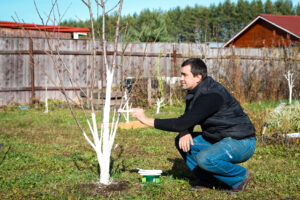 Many people falsely believe that because their trees are dormant during the winter months, they will be just fine and do not need any extra attention. This is not true. Many trees can become dehydrated, suffer from sun damage, have splitting bark, or be destroyed by hungry animals.
Many people falsely believe that because their trees are dormant during the winter months, they will be just fine and do not need any extra attention. This is not true. Many trees can become dehydrated, suffer from sun damage, have splitting bark, or be destroyed by hungry animals.
Dehydration, or desiccation
Dry winters can damage evergreen and coniferous plants. Snow protects the trees from the temperature changes and also moisturizes the soil. When evergreen trees become dehydrated, it is know as desiccation. You can tell if this is happening to your trees if the winter has been very cold but without much snow, and the needles of your trees begin to turn brown, yellow or orange. To prevent dehydration, add mulch around your tree everywhere it has roots, and water your trees before it freezes and on warmer days through the winter.
Sun Damage
During the winter, the sun reflects off of the snow creating a condition known as sunscald, or a tree sunburn. Freezing and thawing sunscald will destroy the bark of the tree, and eventually the tree itself. Fruit trees and young trees are most susceptible to sunscald. There are many ways to prevent sunscald, the most popular being painting the tree trunk white (known as whitewashing), or wrapping the trunks of the trees in tree wrap. Although many people think that whitewashing is outdated, most orchards will use this method before it freezes to protect their trees from the harsh winter.
Splitting Bark
Splitting bark will occur when water freezes inside of small crevices inside the trunk or branches. If you water your trees too much, they will be more prone to splitting bark. Again, young trees are more susceptible to splitting bark than older trees. While splitting bark will not directly kill a tree, it allows bacteria or insects to enter the tree’s defence and they can kill the tree. You can prevent splitting bark by whitewashing the trunks of your trees, or by stop watering your trees after their leaves drop.
Damage From Animals
Many animals, especially deer and rodents, will eat the bark off the tree during the winter, causing it to die. Mice and rabbits will eat a ring of bark off of the tree, also known as girdling, destroying the tree. Deer will also eat the bark off of trees and rub their antlers on the trunks, destroying the bark. Many traditional methods of scaring away deer such as deer repellents, human hair, rosebushes, etc. are ineffective in getting rid of deer. The best protection is fence taller than 7 feet. You can also protect individual plants by wrapping them in burlap or plastic.
